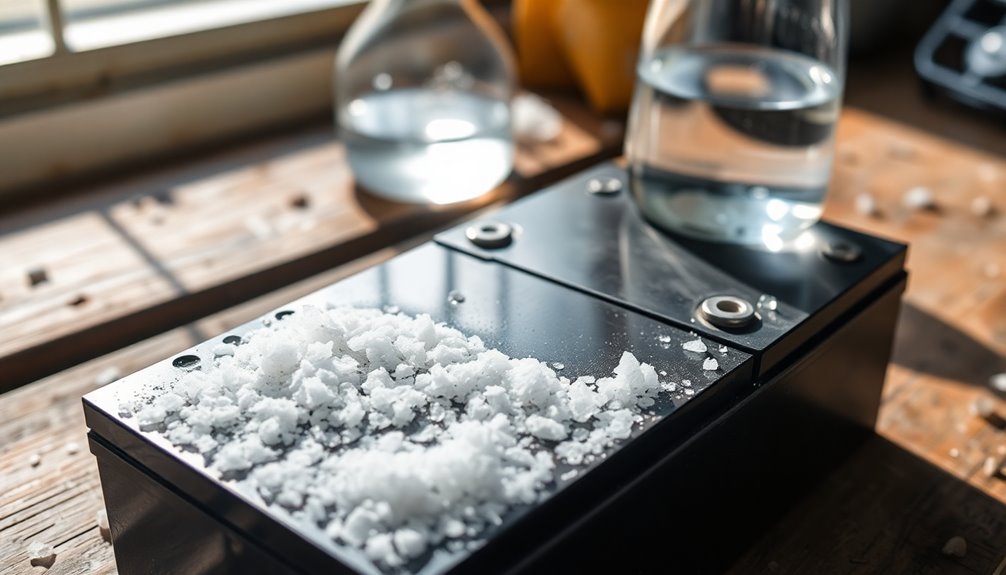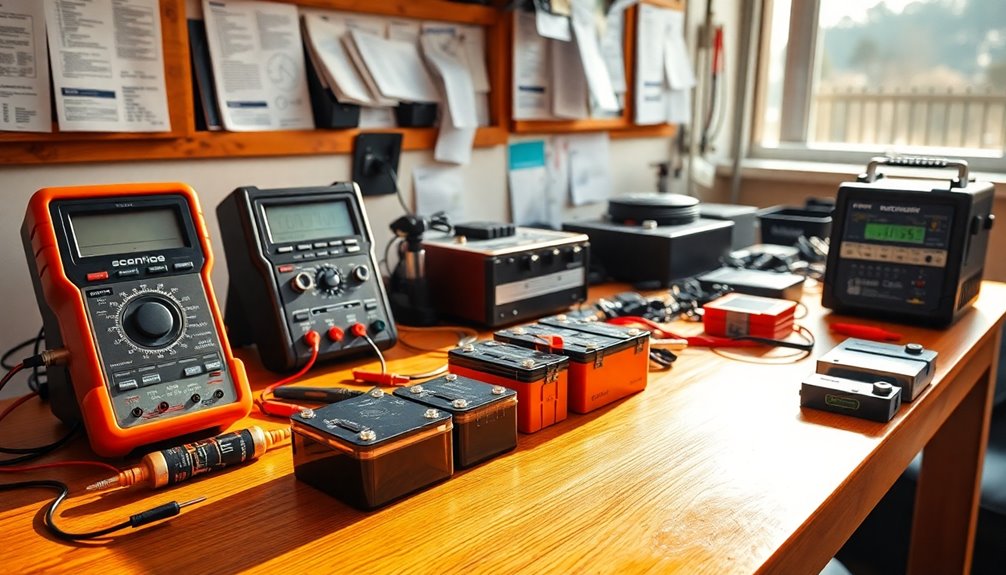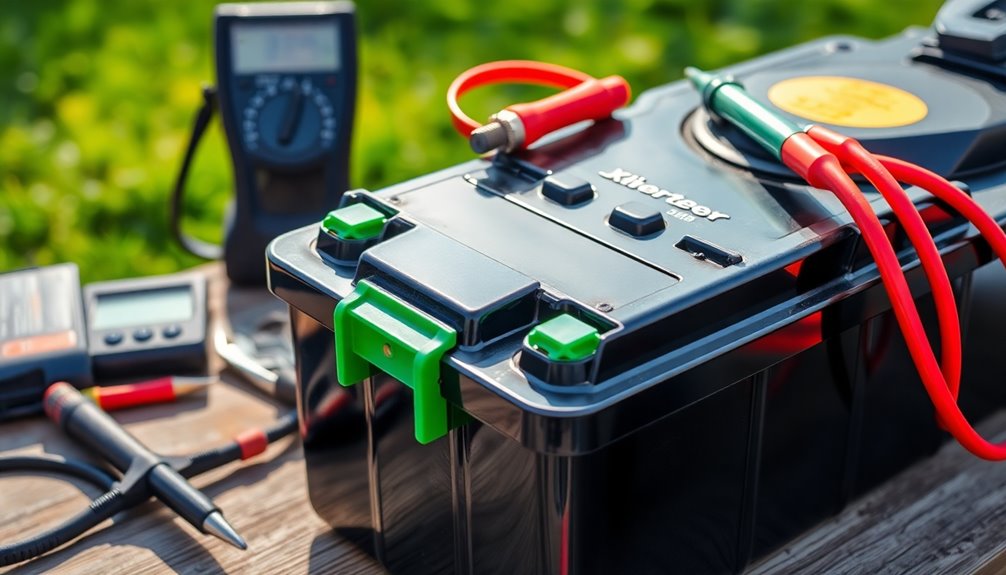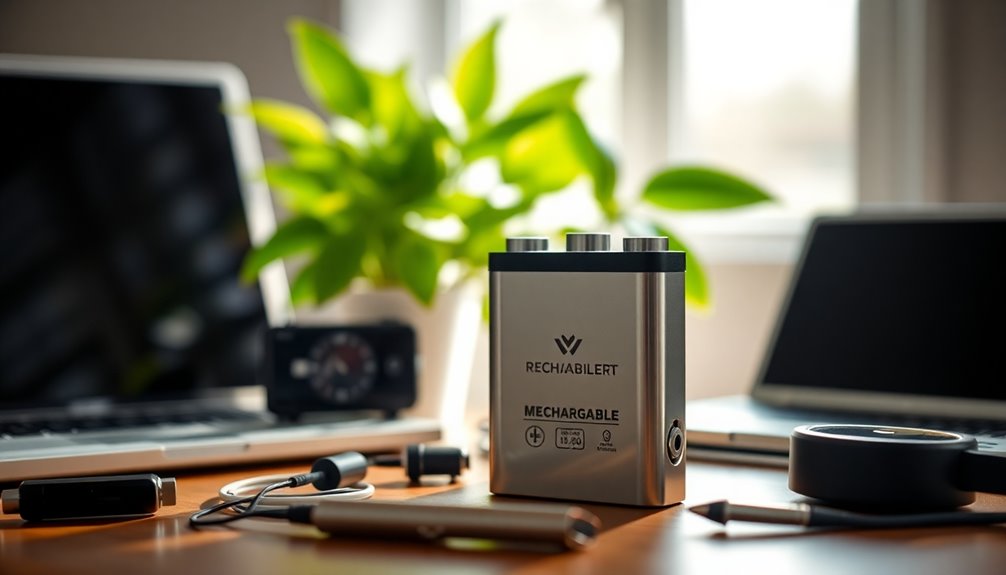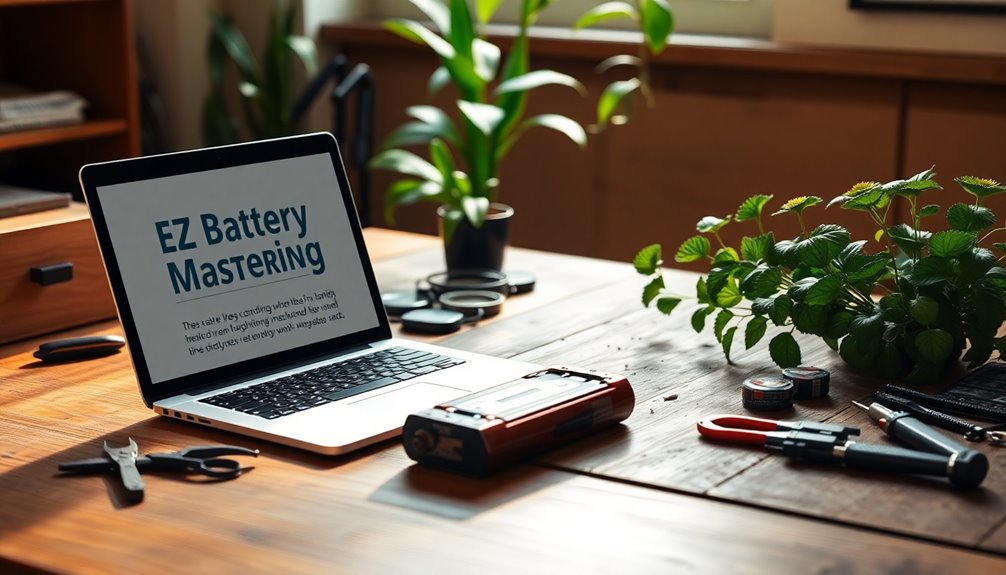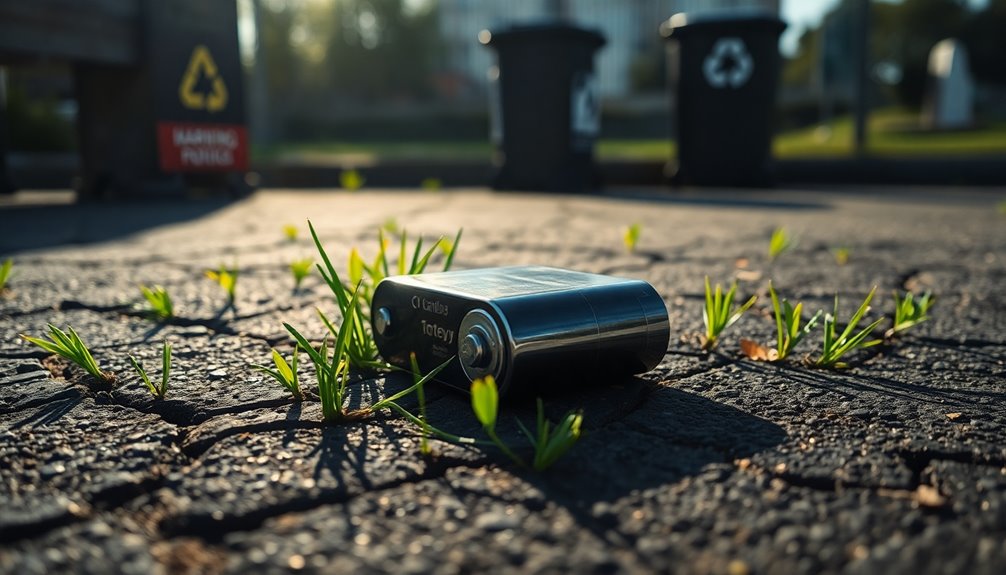Using Epsom salt can help restore lead-acid batteries by combating sulfation. To get started, mix about 5 ounces of Epsom salt in half a quart of heated distilled water until it completely dissolves. Drain the battery's electrolyte and carefully add your solution, ensuring proper safety gear is on. While some users report improved battery life, results may vary based on the battery's condition. Be aware of potential risks, like gas generation, so work outdoors. If you're curious about best practices and alternative methods for battery care, there's more valuable information ahead.
Key Takeaways
- Epsom salt (magnesium sulfate) can help reduce sulfation in lead-acid batteries by dissolving sulfate buildup on battery plates during discharge.
- Prepare a solution by dissolving 5 ounces of Epsom salt in half a quart of heated distilled water for battery treatment.
- Regular equalization charges are recommended alongside Epsom salt, as it may not fully restore battery performance alone.
- Be cautious of risks, including gas generation and potential battery damage; perform treatments outdoors in a well-ventilated area.
- User experiences vary; while some report improved battery life, others find limited effectiveness, suggesting alternative methods like EDTA may be more reliable.
Understanding Epsom Salt

Epsom salt, scientifically known as magnesium sulfate (MgSO4), is a versatile compound with therapeutic properties that many people appreciate. It contains magnesium, oxygen, and sulfur, which contribute to its effectiveness in various applications. You might notice its bitter taste and lack of scent, making it easy to handle. Epsom salt has a monoclinic crystal structure and comes in larger crystals than standard table salt.
You can find Epsom salt in different forms, including anhydrous, monohydrate, and heptahydrate. The heptahydrate form is commonly known as epsomite, while the monohydrate form is referred to as kieserite. Naturally, it occurs in mineral deposits and near springs, but it can also be synthesized in laboratories.
One of its standout features is its high solubility in water, especially when heated. In its anhydrous form, it dissolves at a rate of 26.9 grams per 100 milliliters. Additionally, the hydrated form is the prevalent state for most applications, making it widely available for various uses.
Epsom salt remains stable under proper storage conditions, so it's essential to keep it away from extreme temperatures and direct sunlight. Overall, this compound's unique properties make it a valuable resource for various needs.
Preparation of the Solution

To kick off the preparation of the Epsom salt solution, start by heating distilled water to about 66ºC (150ºF).
In a bucket or container, measure out the right amounts of Epsom salt and water. A good ratio is 5 ounces of Epsom salt for every half-quart of distilled water.
Once the water's heated, pour it into the container and add the Epsom salt. Stir until the salt is fully dissolved, ensuring you avoid any undissolved particles, which shouldn't go directly into the battery.
Before you begin this process, wear gloves, goggles, and an apron for safety. Regular charging is essential to prevent sulfation and maintain battery health, which can enhance the effectiveness of your rejuvenation efforts.
Once your solution's ready, it's time to prepare the battery cells. Drain the existing electrolyte using a turkey baster, making sure to measure and record how much you remove.
Then, neutralize the battery acid with a baking soda and distilled water mixture. Clean the cells thoroughly with this mix to ensure no residue remains.
After that, pour the Epsom salt solution into the battery cells, filling them just below the full level. Avoid overfilling, as this can create issues during charging.
Your solution is now ready for use.
How It Works

Adding Epsom salt to lead-acid batteries is believed to help combat the sulfation process that degrades battery performance. When you add magnesium sulfate to the battery cells, it's thought to dissolve the sulfate buildup on the battery plates. This buildup occurs during discharge, transforming the lead plates into lead sulfate.
Importantly, the magnesium sulfate doesn't increase the sulfuric acid concentration necessary for discharge, meaning it won't directly boost your battery's output. In fact, a poor battery condition can already indicate significant sulfation, which Epsom salt alone may not fully remedy.
When you mix Epsom salt with distilled water and pour it into the battery, it interacts with the lead sulfate. This interaction is meant to reduce sulfation, but it's crucial to note that it doesn't enhance battery capacity or performance. The solution can temporarily alter the specific gravity reading but won't provide a lasting improvement.
Additionally, regular use of Epsom salt may lead to deposits of lead "silt" in the battery, potentially causing damage. While it can increase plate porosity, it doesn't tackle the root causes of sulfation or stratification.
For better results, consider regular equalization charges and other maintenance practices instead of relying solely on Epsom salt.
Reported Effectiveness
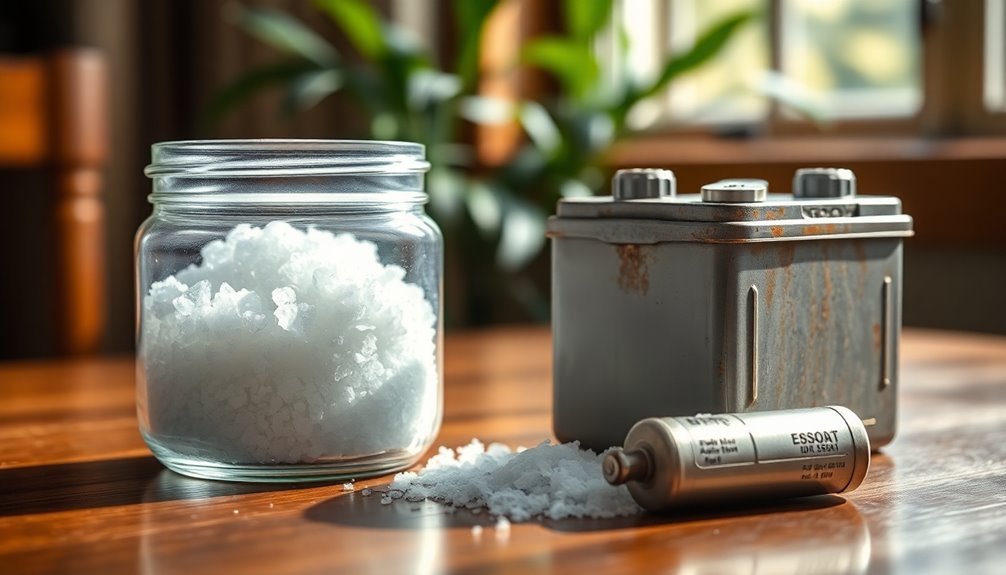
Reported effectiveness of Epsom salt in lead-acid battery restoration varies significantly among users. Many report positive outcomes, noting that Epsom salt can extend the life of flooded lead-acid batteries by reducing internal resistance and desulfating the plates.
When you dissolve Epsom salt in warm water and replace the old electrolyte with this solution, you might see a restoration of some original capacity, with cases of run time increasing from just 30 seconds to over 1.5 hours after treatment.
However, mixed results exist. Some users find the method effective, especially for lightly used batteries, while others view it as a waste of time. The effectiveness can hinge on the battery's condition and age, with some showing significant improvement and others showing minimal change. Additionally, many users report that reconditioning can save on new battery costs, enhancing the appeal of this method.
The process can be lengthy and messy, requiring careful handling. While this method has been used for over 30 years and can maintain older batteries, it may not be the best approach for all lead-acid types.
It's important to remember that results can vary, and repeated treatments may be necessary to achieve the desired desulfation effect.
Risks and Limitations
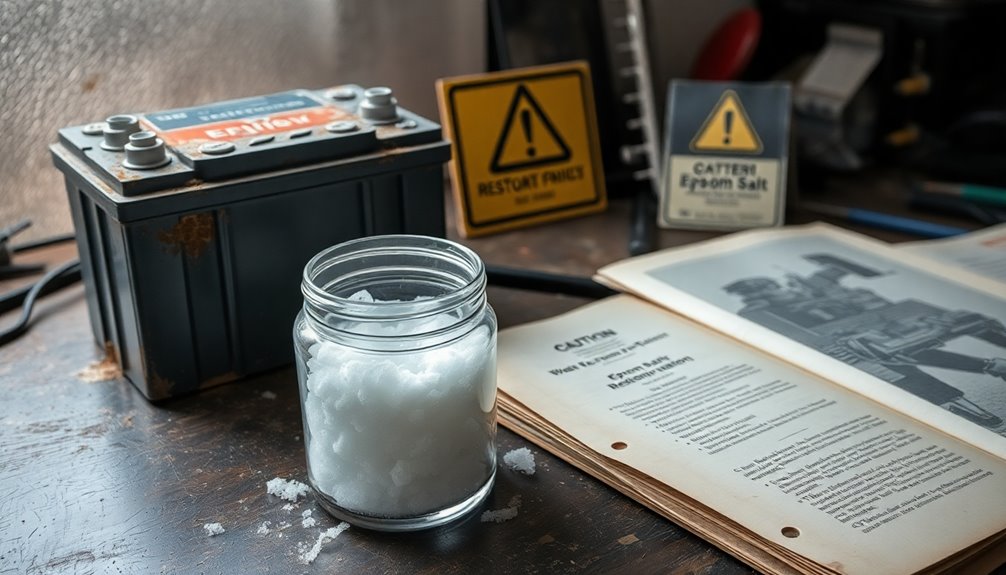
Using Epsom salt for lead-acid battery restoration comes with several risks and limitations that you should consider before attempting the process. One major concern is the potential for explosion. When you add Epsom salt, it can generate excessive hydrogen and oxygen gases, overwhelming the battery's vent caps and increasing the risk of an explosion.
It's crucial to perform this process outdoors and away from flammable materials.
Moreover, the high-rate charging often recommended can damage the battery, causing a permanent loss of capacity. While Epsom salt might temporarily increase specific gravity readings, it doesn't truly improve battery performance. The sulfates it introduces aren't available for discharge and won't enhance the sulfuric acid concentration necessary for proper function. Additionally, this method can leave harmful deposits, leading to eventual battery failure. You'll find that the process is messy and may require multiple applications for any temporary benefits.
Instead, regular maintenance, like keeping the battery fully charged, proves to be a more effective and reliable solution for preventing sulfation and prolonging battery life. Always approach this method with caution and an understanding of its limitations. Chemical desulfators are generally not recommended due to their ineffectiveness and potential contamination risks.
Alternative Restoration Methods
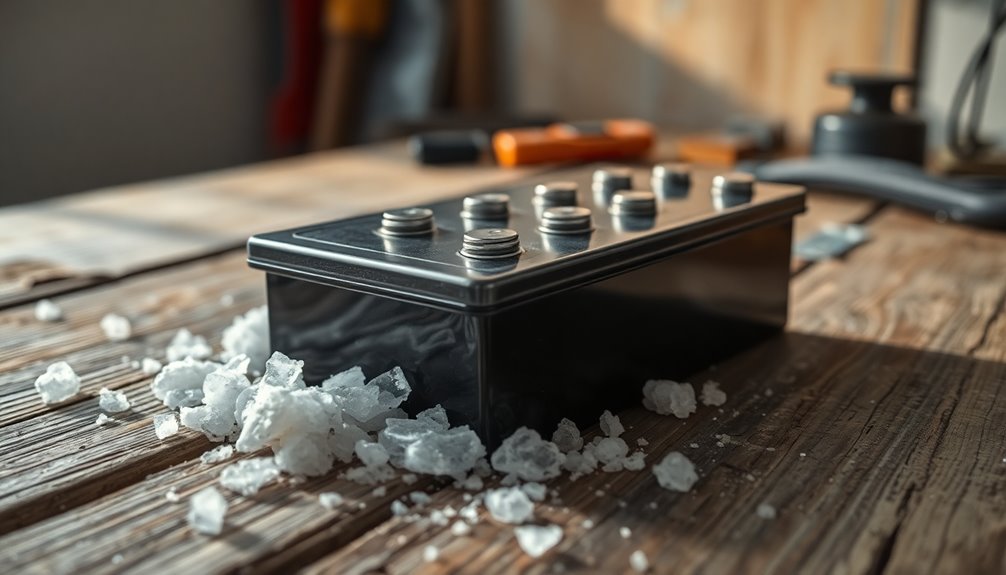
While Epsom salt may seem like a quick fix for lead-acid battery restoration, there are safer and potentially more effective methods available.
One method you might consider is equalization charging. This technique involves using an equalizer charger or manually charging each cell to balance charge levels. By applying higher voltage at lower amperage, you can help dislodge sulfates from the plates, though it may take time and require specialized equipment. This method is particularly beneficial because it addresses the common issue of capacity decrease over time.
Another option is to use chemical additives like EDTA, which some experts believe is more effective than Epsom salt for desulfation. It increases plate porosity, but it's important to handle it carefully due to potential long-term damage.
If you're looking for a gentler method, slow charging at about 10% of the rated amperage can help avoid overheating while maintaining proper electrolyte levels.
Don't forget about physical maintenance, either. Regularly inspecting your battery for damage, cleaning terminals, and ensuring solid connections can make a significant difference.
This holistic approach can enhance your battery's performance and longevity beyond what Epsom salt alone can achieve.
Expert Insights
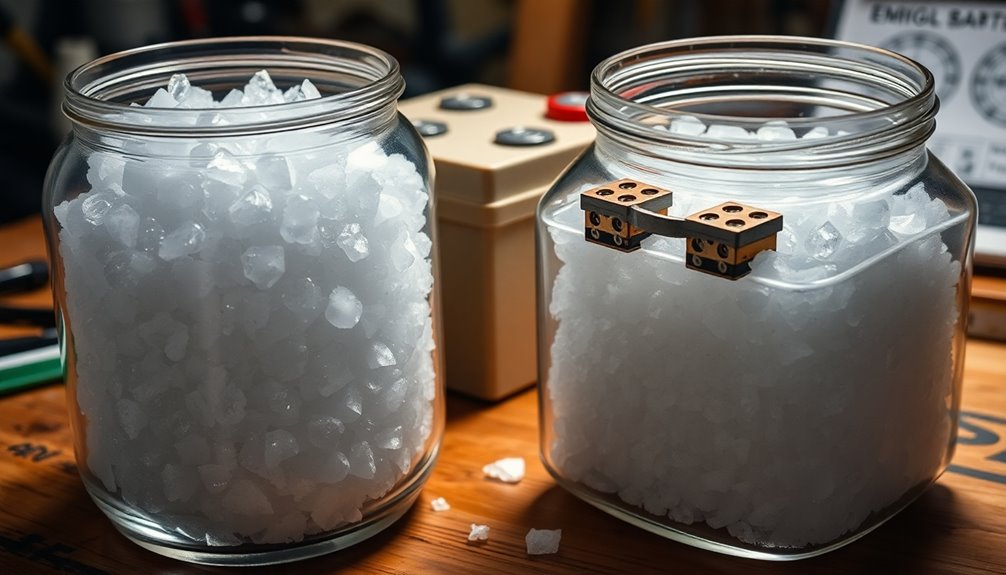
What do experts really think about using Epsom salt for lead-acid battery restoration? The opinions are quite mixed. While some users swear by their success in reviving dead batteries with Epsom salt, others raise concerns about its effectiveness.
Experts like Fred Wehmeyer argue that while Epsom salt can artificially boost specific gravity, it doesn't genuinely enhance battery performance or longevity. The method is often described as long and messy, with user experiences varying significantly. For some, the results are impressive, while others see no noticeable improvements.
It's important to note that Epsom salt acts primarily by dissolving sulfate buildup on the battery plates, but this doesn't translate to restored capacity. Moreover, adding Epsom salt can lead to artificially improved readings without addressing deeper issues like shorts or physical damage within the battery. Additionally, long-term performance assessments show that while some batteries may temporarily improve, they often still suffer from underlying issues that Epsom salt cannot fix.
There's also potential risk involved over time, with some experts suggesting that alternatives like EDTA might yield better desulfation results. Ultimately, while Epsom salt could work for some, it's not a guaranteed solution for everyone. Make sure to weigh these expert insights before deciding on your restoration approach.
Best Practices for Battery Care

Maintaining your lead-acid battery is crucial for ensuring its longevity and performance. Start by prioritizing safety—always wear protective clothing, gloves, and goggles when handling batteries.
Keep flames, sparks, and metal objects away to prevent short circuits and fires. Charge your battery in a well-ventilated area to avoid inhaling harmful fumes. Regularly inspect and clean your battery. Keep it dry and free from corrosion, and make sure vent caps are tight. Use a baking soda solution to clean any acid residue and apply protective spray or petroleum jelly on terminals to reduce corrosion.
When it comes to watering and charging, add distilled water only when the plates are exposed and just enough to cover them. It is essential to maintain proper water levels to ensure optimal performance and prevent damage. Check water levels every 15-30 days and use a smart charger that adjusts the charge rate for optimal performance.
Store your battery fully charged in a cool, dry place to prevent sulfation. Check the charge periodically and consider using a maintenance charger.
Lastly, disconnect the battery from equipment during long-term storage to avoid passive discharge. Following these best practices will help keep your lead-acid battery in peak condition.
Frequently Asked Questions
Can Epsom Salt Harm Newer Battery Models?
Yes, Epsom salt can harm newer battery models.
When you add it, it might artificially boost the specific gravity reading, but that won't improve performance.
The magnesium sulfate doesn't help discharge lead sulfate, which is essential for battery function.
Instead, it can create lead "silt" at the bottom and cause further issues.
Relying on Epsom salt could ultimately shorten your battery's lifespan, so it's best to avoid using it altogether.
How Often Can I Use Epsom Salt for Restoration?
You shouldn't use Epsom salt too often for battery restoration. Ideally, limit it to once a year to avoid increasing corrosion on the lead plates and internal connectors.
If you do use it, make sure to flush the battery with distilled water afterward.
What Are Signs of Sulfation in a Battery?
You'll notice signs of sulfation in your battery through various symptoms.
If you experience diminished performance, such as difficulty starting your vehicle or shorter run times between charges, it's a clear indicator.
You might also see physical signs like a swollen battery case or persistent heat during operation.
If your battery takes longer to charge or shows low electrolyte levels, these are further signs that sulfation may be occurring.
Is There a Specific Temperature for the Solution?
Yes, there's a specific temperature for dissolving Epsom salt effectively. You should heat distilled water to around 66ºC (150ºF).
This temperature helps the salt dissolve completely, enhancing its effectiveness. Avoid boiling the water to prevent evaporation, and use a thermometer to check the temperature.
Stir continuously until the Epsom salt fully dissolves. Keeping the right temperature is key to ensuring a uniform solution, so don't use cold water.
Can I Use Epsom Salt on Sealed Batteries?
You can't use Epsom salt on sealed batteries.
These batteries are designed to be maintenance-free, so you can't access the internal cells to replace the electrolyte. Attempting to modify them can damage the battery and void its warranty.
Instead of chemical treatments, focus on regular maintenance like checking voltage levels and using a digital voltmeter.
If the battery's failing, it's often better to replace it rather than try unapproved methods.
Conclusion
In conclusion, using Epsom salt for lead-acid battery restoration can be a viable option, but it's essential to understand its limitations. While it may improve performance in some cases, it's not a guaranteed fix. Always weigh the risks and consider alternative methods if necessary. By following best practices for battery care, you can maximize your battery's lifespan and efficiency. Remember, regular maintenance and proper usage are key to keeping your batteries in top shape.

